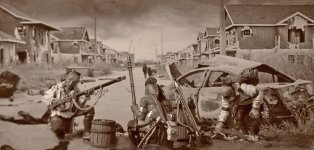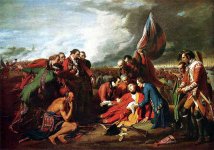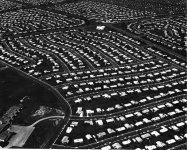PolarBear
Major
- Joined
- Feb 24, 2007
- Messages
- 6,706
“The Road To Civilization”
This photograph represents another juxtaposition of military miniatures from the French & Indian War era (1754-1763) and a setting utilizing a still from the 2009 film The Road. The still shows that section of the movie that was filmed amid the still unrepaired damage of post Katrina New Orleans. Director John Hillcoat selected New Orleans as one of his 50 locations as a place that would convey the look of a post apocalyptic world that is the environment in which the story takes place. In the mid center of the image are the film’s main characters the Man and Boy (VIggo Mortensen and Kodi Smit-McPhee) scavenging for food or other items that will help them survive in their nomadic journey across the ruins of their nation.
The title of the photograph is ironic and questions what has really been gained on “The Road To Civilization”. The use of Indians in the foreground is meant to recall the debates about “savage” versus “civilized” prevalent in the 18th and 19th centuries. Indians were very much a part of this debate. It was in the 18th C that the concept of the “Noble Savage” was added to the cultural discourse of the Enlightenment. The Noble Savage was seen as the natural man
unencumbered by civilization. In the state of nature, like the Indian, man was seen as essentially good. This point of view served as a counterweight to the Indian as a cruel, barbaric savage. Benjamin West’s 1770 painting of the Death of Wolfe includes a good example of the ideal of the noble savage. The concept of indigenous peoples living harmoniously in nature served as a springboard in the 19th C for the Western fascination with primitivism as an antidote to over civilization. Probably the best known example of this was French painter Paul Gauguin who gave up his job as a stockbroker to pursue his art ultimately among the “savages” of Tahiti.
The Indians in the foreground of “The Road to Civilization” are representative of the impact of Western civilization on the native populations of North America during the Colonial era. They are already armed with the tools and implements of European culture (muskets and steel axes) and have just found more of the same that they are eagerly adding to their booty.
Placing the Indians in the context of New Orleans was intentional. New Orleans is part of Louisiana and provides a direct link to the future plight of the American Indian in North America. In 1803, President Thomas Jefferson bought the Louisiana territory from Napoleon for the purpose of expanding lands for American settlement. It was at this time that the idea of the peaceful removal of the Indians to lands beyond the Mississippi began to take shape. The presence of the indigenous peoples eventually was seen as an impediment to progress and subsequently during the administration of Andrew Jackson this removal was carried out forcibly against the Cherokees leading to the infamous “Trail of Tears.”
The fragility of Civilization and the breakdown of society as represented in Cormac McCarthy’s novel and Hillcoat’s film have taken on a new meaning and poignancy epitomized by New Orleans after the natural disaster of Katrina in 2005 and the man-made catastrophe of the BP oil spill in 2010.
This photograph represents another juxtaposition of military miniatures from the French & Indian War era (1754-1763) and a setting utilizing a still from the 2009 film The Road. The still shows that section of the movie that was filmed amid the still unrepaired damage of post Katrina New Orleans. Director John Hillcoat selected New Orleans as one of his 50 locations as a place that would convey the look of a post apocalyptic world that is the environment in which the story takes place. In the mid center of the image are the film’s main characters the Man and Boy (VIggo Mortensen and Kodi Smit-McPhee) scavenging for food or other items that will help them survive in their nomadic journey across the ruins of their nation.
The title of the photograph is ironic and questions what has really been gained on “The Road To Civilization”. The use of Indians in the foreground is meant to recall the debates about “savage” versus “civilized” prevalent in the 18th and 19th centuries. Indians were very much a part of this debate. It was in the 18th C that the concept of the “Noble Savage” was added to the cultural discourse of the Enlightenment. The Noble Savage was seen as the natural man
unencumbered by civilization. In the state of nature, like the Indian, man was seen as essentially good. This point of view served as a counterweight to the Indian as a cruel, barbaric savage. Benjamin West’s 1770 painting of the Death of Wolfe includes a good example of the ideal of the noble savage. The concept of indigenous peoples living harmoniously in nature served as a springboard in the 19th C for the Western fascination with primitivism as an antidote to over civilization. Probably the best known example of this was French painter Paul Gauguin who gave up his job as a stockbroker to pursue his art ultimately among the “savages” of Tahiti.
The Indians in the foreground of “The Road to Civilization” are representative of the impact of Western civilization on the native populations of North America during the Colonial era. They are already armed with the tools and implements of European culture (muskets and steel axes) and have just found more of the same that they are eagerly adding to their booty.
Placing the Indians in the context of New Orleans was intentional. New Orleans is part of Louisiana and provides a direct link to the future plight of the American Indian in North America. In 1803, President Thomas Jefferson bought the Louisiana territory from Napoleon for the purpose of expanding lands for American settlement. It was at this time that the idea of the peaceful removal of the Indians to lands beyond the Mississippi began to take shape. The presence of the indigenous peoples eventually was seen as an impediment to progress and subsequently during the administration of Andrew Jackson this removal was carried out forcibly against the Cherokees leading to the infamous “Trail of Tears.”
The fragility of Civilization and the breakdown of society as represented in Cormac McCarthy’s novel and Hillcoat’s film have taken on a new meaning and poignancy epitomized by New Orleans after the natural disaster of Katrina in 2005 and the man-made catastrophe of the BP oil spill in 2010.




